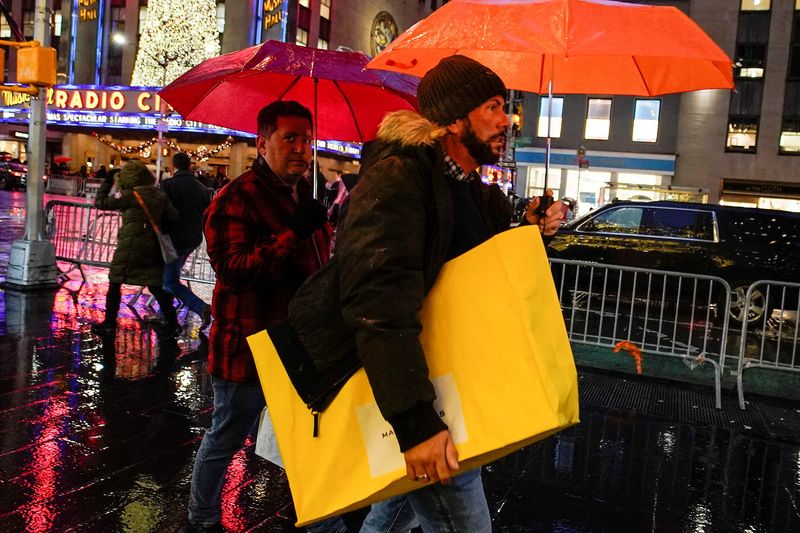By Lucia Mutikani
WASHINGTON (Reuters) - The U.S. economy grew faster than expected in the fourth quarter, but that likely exaggerates the nation's health as a measure of domestic demand rose at its slowest pace in 2-1/2 years, reflecting the impact of higher borrowing costs.
The Commerce Department's advance fourth-quarter gross domestic product report on Thursday showed half of the boost to growth came from a sharp rise in inventory held by businesses, some of which is likely unwanted.
While consumer spending maintained a solid pace of growth, a big chunk of the increase in consumption was early in the fourth quarter. Retail sales weakened sharply in November and December. Business spending on equipment contracted last quarter and is likely to remain on the backfoot as demand for goods softens.
It could be the last quarter of solid GDP growth before the lagged effects of the Federal Reserve's fastest monetary policy tightening cycle since the 1980s are fully felt. Most economists expect a recession by the second half of the year, though a short and mild one compared to previous downturns, because of extraordinary labor market strength.
"The U.S. economy isn't falling off a cliff, but it is losing stamina and risks contracting early this year," said Sal Guatieri, a senior economist at BMO Capital Markets in Toronto. "That should limit the Fed to just two more small rate increases in coming months."
Gross domestic product increased at a 2.9% annualized rate last quarter. The economy grew at a 3.2% pace in the third quarter. Economists polled by Reuters had forecast GDP would rise at a 2.6% rate.
Robust second-half growth erased the 1.1% contraction in the first six months of the year. For 2022, the economy expanded 2.1%, down from the 5.9% logged in 2021. The Fed last year raised its policy rate by 425 basis points from near zero to a 4.25%-4.50% range, the highest since late 2007.
Consumer spending, which accounts for more than two-thirds of U.S. economic activity, grew at a 2.1% rate, mostly reflecting a rebound in goods spending at the start of the quarter, mostly on motor vehicles. Consumers also spent on services like healthcare, housing, utilities and personal care.
Spending, which grew at a 2.3% pace in the third quarter, has been underpinned by labor market resilience as well as excess savings accumulated during the COVID-19 pandemic. Income at the disposal of households after accounting for inflation increased at a 3.3% rate after rising at a 1.0% pace in the third quarter. The saving rate rose to 2.9% from 2.7%.
But demand for long-lasting manufactured goods, which are mostly bought on credit, has fizzled and some households, especially lower income, have depleted their savings.
As a result, inventories surged at a $129.9 billion rate compared to a $38.7 billion rate in the prior quarter, adding 1.46 percentage points to GDP growth. There also were contributions from government spending and a smaller trade deficit.
Stripping out inventories, government spending and trade, domestic demand increased at only a 0.2% rate. That was the smallest increase in private domestic final sales since the second quarter of 2020 and was a deceleration from the third quarter's 1.1% pace.
"Rising inventories could bode poorly for growth in early 2023 as corporations may look to reduce excess stocks of goods," said Erik Norland, senior economist CME Group (NASDAQ:CME).
Stocks on Wall Street were trading higher. The dollar rose against a basket of currencies. Prices of U.S. Treasuries fell.
ROLLING RECESSION
Despite clear signs of a weak handover to 2023, some economists are cautiously optimistic the economy will skirt an outright recession, suffering instead a rolling downturn where sectors decline in turn rather than all at once.
They argue that monetary policy now acts with a shorter lag than was previously the case because of advances in technology and the U.S. central bank's transparency, which they said resulted in financial markets and the real economy acting in anticipation of rate hikes.
Though residential investment suffered its seventh straight quarterly decline, the longest such streak since the collapse of the housing bubble triggered the 2007-2009 Great Recession, there are signs the housing market could be stabilizing.
Mortgage rates have been trending lower as the Fed slows the pace of its rate hikes.
"A large portion of the reaction to higher interest rates is already in the economy and the financial markets," said Sung Won Sohn, a finance and economics professor at Loyola Marymount University in Los Angeles. "Since the Fed has succeeded in precipitating a rolling recession, it is time to think about an exit strategy."
Inflation also subsided in the fourth quarter. A measure of inflation in the economy rose at a 3.2% rate, retreating from the third quarter's 4.8% pace of increase.
While many parts of the economy have shifted to lower gear, the labor market is showing no signs substantial cooling.
A separate report from the Labor Department on Thursday showed initial claims for state unemployment benefits fell 6,000 to a seasonally adjusted 186,000 for the week ended Jan. 21, the lowest level since April 2022. The number of people receiving benefits after an initial week of aid, a proxy for hiring, increased 20,000 to 1.675 million for the week ended Jan. 14.

Companies outside the technology industry as well as interest-rate sensitive sectors like housing and finance are hoarding workers after struggling to find labor during the pandemic.
"There are no signs in the latest jobless claims data that the labor market is cracking at the start of the new year," said Conrad DeQuadros, senior economic advisor at Brean Capital in New York.
